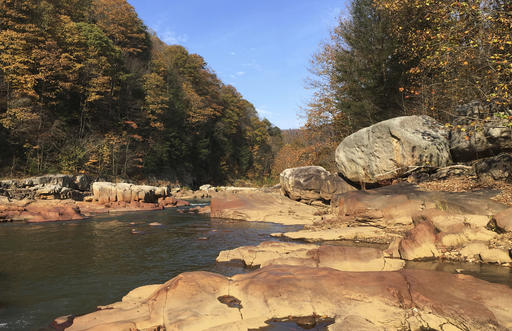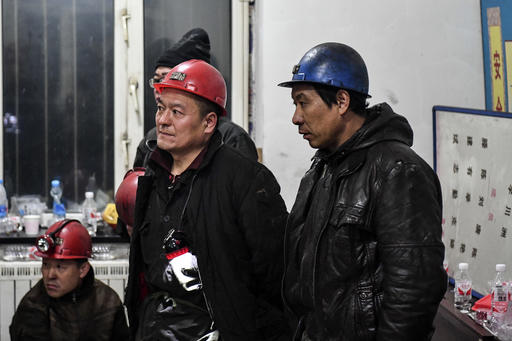Friday roundup, Dec. 2, 2016
December 2, 2016 by Ken Ward Jr.
In this Wednesday, Nov. 30, 2016 photo released by Xinhua News Agency, a man takes a picture near a coal mine which has trapped dozens workers in Qitaihe City, northeast China’s Heilongjiang Province. The managers of an apparently unregistered coal mine in northeast China are under questioning as rescuers tried Thursday to reach workers trapped for a third day. (Wang Song/Xinhua via AP)
Earlier this week, the New York Times had a story headlined, “Despite climate change vow, China pushes to dig more coal,” reporting:
America’s uncertain stance toward global warmingunder the coming administration of Donald J. Trump has given China a leading role in the fight against climate change. It has called on the United States to recognize established science and to work with other countries to reduce dependence on dirty fuels like coal and oil.
But there is a problem: Even as it does so, China is scrambling to mine and burn more coal.
A lack of stockpiles and worries about electricity blackouts are spurring Chinese officials to reverse curbs that once helped reduce coal production. Mines are reopening. Miners are being lured back with fatter paychecks.
China’s response to coal scarcity shows how hard it will be to wean the country off coal. That makes it harder for China and the world to meet emissions targets, as Chinese coal is the world’s largest single source of carbon emissions from human activities.
In this Wednesday, Nov. 30, 2016 photo released by Xinhua News Agency, rescuers and workers attend a briefing before conducting a search and rescue operation for workers trapped inside a coal mine in Qitaihe City, northeast China’s Heilongjiang Province. (Wang Song/Xinhua via AP)
Interestingly enough, as the Wall Street Journal reports:
A deadly quarry collapse in northeast China this week reflects a surge in dangerous mining activity across the country as coal prices soar, following a government warning that the rally poses increased casualty risks.
The warning, in a report in early November, came as informal data have shown sharp increases in colliery casualties this year, with November the deadliest month so far.
On Tuesday, 22 workers were trapped when a shaft caved in at Qitaihe City Jingyou Coal Mine, a desolate outpost in China’s northeast, state-run Xinhua News Agency quoted rescue workers as saying on Wednesday. The cause wasn’t immediately known, nor was it clear whether any of those trapped had survived.
Last week, a coal-mine fire in neighboring Liaoning province killed 26 miners.
The Work Safety Committee of the State Council, a government agency, also said it would step up surprise inspections, including at night, to counter “illegal practices” at mines that put lives at risk.
“As coal prices go up, mines tend to go beyond the usual safety limits to get at the more dangerous coal, and accidents increase,” saidKeegan Elmer, a researcher for the Hong Kong-based watchdog China Labour Bulletin.
Also this week, Mother Jones had this important story:
As the clock ticks down to the beginning of Donald Trump’s presidency, the Obama administration is moving to enact one final measure aimed at cutting coal pollution. According to a spokesperson for the Interior Department, the administration intends to release an update to a decades-old regulation protecting streams from the impacts of mining before Obama leaves office on January 20.
Obama’s climate and environmental policies have largely been defined by a slew of executive actions and new regulations, including limits on carbon and mercury emissions from coal-fired power plants; new fuel efficiency standards; and a moratorium on new coal leases on public lands. In recent weeks, the administration has finalized a rule that seeks to limit methane emissions from oil and gas facilities and has placed a chunk of the Arctic off limits to further offshore drilling.
… Derek Teaney, senior attorney with the nonprofit Appalachian Mountain Advocates, says environmentalists have been waiting years for the rule to be strengthened. It was last updated by the Bush administration in 2008, and critics complained those changes left coal companies with too many loopholes. The Bush-era revisions were challenged in court by environmental groups, and the Interior Department withdrew them in 2014 … The “Obama administration has frittered away its time,” said Teaney.

In this Nov. 1, 2016 photo, the Cheat River runs green and slate gray and low among brown boulders in the whitewater canyon. It was recently bought by the state and environmentalists to protect the once badly polluted river, its tributaries and wildlife. In 1994, the river was bright orange from a blowout in an abandoned coal mine that spewed acid and metals into the waterway. (AP Photo/Michael Virtanen)
Meanwhile, the AP had this story about West Virginia’s Cheat River:
The Cheat River flows pale green and slate gray, glistening in the sunshine as it gathers speed, turns to whitewater and drops between rocks on the way toward the Monongahela River. From there it makes its way to the Ohio River and the drinking water of millions of people.
As West Virginia pushes toward an uncertain economic future, a river that once flowed bright orange charts a course out of mining’s toxic legacies.
The state recently joined conservationists to protect the Cheat’s eight-mile whitewater canyon, collectively buying 3,800 acres from timber investors for $7 million. A new $8 million water treatment plant next year should help alleviate ongoing acid drainage from an abandoned underground coal mine that blew out in 1994, spewing acid and metals.
“In the East, it’s a rare opportunity where you get to protect eight river miles along an area that not only has tremendous biodiversity but also has a lot of recreational opportunities available,” said the Nature Conservancy’s Keith Fisher, a biologist.

 Subscribe to the Coal Tattoo
Subscribe to the Coal Tattoo

